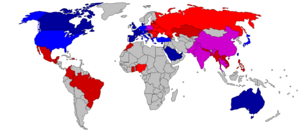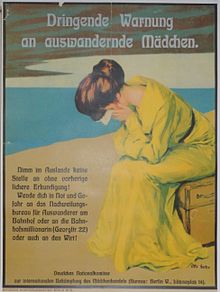Human trafficking


Human trafficking (or Trafficking in human beings) is a way to exploit people. People are sold, bought, traded much like slaves , and are even sold to couples who don't have children. It is estimated to be a $5 to $9 billion-a-year industry.[1] Trafficking victims typically are recruited by using force or because they are deceived, or fraud is used, power is abused, or they are simply abducted. Threats, violence, and economic problems can often make a victim consent to exploitation.
Human trafficking should not be confused with human smuggling.[2][3][4]
General[change | change source]
Exploitation includes forcing people into prostitution or other forms of sexual exploitation, forced labour or services, slavery or practices similar to slavery, servitude or the removal of organs. For children exploitation may also include forced prostitution, illegal international adoption, trafficking for early marriage, or recruitment as child soldiers, beggars, for sports (such as child camel jockeys or football players), or for religious cults.[5]
The norms based on international human rights law, such as Vienna Declaration[6] and the Yogyakarta Principles[7] prohibit human trafficking and Council of Europe and Charter of Fundamental Rights of European Union also prohibit them and do effort to save the victims.
Sex trafficking[change | change source]
Sex trafficking is human trafficking, where the main idea is to trick or force people so they can be used for sexual needs. This is fundamentally different from sex work or prostitution. Prostitution and sex work is legal in many countries. Human trafficking is almost always illegal.
Who are the victims?[change | change source]

Many are women, but it is not rare for men to also be trafficked. Their ages, ethnic and their socioeconomic background all vary. Still there are groups of people that are more high-risk.[8][9]
- Homeless and runaway young people
- People that move from other countries and have low resources
- People who have gone through physical, emotional, or sexual abuse
- People who have been mistreated in their life and have low social skills
Who does it?[change | change source]
In 2017 they analyzed 1,416 child sex traffickers that were arrested in the United States in the past 10 years and it was found that 75.4% of traffickers are male and 24.4% are female. In average they were younger than 30 years. [10]
Ways of trafficking[change | change source]
- Trafficking controlled by pimps: A person is controlled by one trafficker called a pimp. They sometimes use promises of marriage or possible modeling chances to attract victims. [11] Other times they simply use intimidation, brainwashing and kidnapping.
- Trafficking done by gangs: It is a lot like pimp-controlled trafficking, but a person is controlled by a large group of people. [12] They can also attract people by making them trust them. Gangs now have been using sex trafficking because it is safer and leaves more money than drug trafficking.
- Trafficking done by a person's family: The person is controlled by members of their own families. They let them be exploited and ask for something in return, usually drugs or money.
- Trafficking done by cybersex: Cybersex trafficking means the live streaming of forced sexual acts and/or rape on camera of trafficked victims. [13][14][15]
- Forced marriage: When a person is sent to another country, forced into a marriage and then is forced to participate in sexual conduct with their new partner, then the experience is considered sex trafficking. [16]
Child trafficking[change | change source]
Child trafficking is defined as the "recruitment, transportation, transfer, harboring, and/or receipt" of a child for the purpose of exploitation.[17] The commercial sexual exploitation of children can take many forms. This includes forcing a child into Child prostitution[18] or it can be other forms of sexual activity like child pornography. Exploitation may also involve forced labour or services like slavery. It can mean practices similar to slavery such as servitude or the removal of organs, illegal adoption, or recruitment as child soldiers.[19]
Related pages[change | change source]
- Hague Adoption Convention
- Gaslighting - A form of psychological abuse that can make human trafficking easier
- Forced marriage
- Child marriage
- Political corruption
References[change | change source]
- ↑ "Economic Roots of Trafficking in the UNECE Region".
- ↑ "The difference between human trafficking and smuggling".
- ↑ Quan, Douglas (21 June 2019). "Alleged human-smuggling operation may have brought hundreds of Chinese migrants across B.C. Border". National Post.
- ↑ "Human Trafficking and Migrant Smuggling". Archived from the original on 2018-12-12. Retrieved 2019-06-22.
- ↑ "Agents in the UEFA spotlight".
- ↑ Vienna Declaration, Part I para 18
- ↑ Yogyakarta Principles, Article 11
- ↑ Hammond, Gretchen Clark; McGlone, Mandy (December 2014). "Entry, Progression, Exit, and Service Provision for Survivors of Sex Trafficking: Implications for Effective Interventions". Global Social Welfare. 1 (4): 157–168. doi:10.1007/s40609-014-0010-0. ISSN 2196-8799. S2CID 144762002.
- ↑ "List of Reviewers October 2014-September 2015". Human Resource Management Journal. 25 (4): 617–623. November 2015. doi:10.1111/1748-8583.12089. ISSN 0954-5395.
- ↑ Roe-Sepowitz, Dominique (2019). "A Six-Year Analysis of Sex Traffickers of Minors: Exploring Characteristics and Sex Trafficking Patterns" (PDF). Journal of Human Behavior in the Social Environment. 29 (5): 608–629. doi:10.1080/10911359.2019.1575315. S2CID 150678437. Archived from the original (PDF) on 2021-12-25. Retrieved 2021-12-25.
- ↑ Terry, April (2017-12-31). "Sex Trafficking: What We Don't Know and How to Fix It". Journal of Global Engagement and Transformation. 1 (2). doi:10.52553/10002h. ISSN 2572-455X.
- ↑ "6. From Criminalization to Decriminalization: Local Responses to Domestic Minor Sex Trafficking". Domestic Minor Sex Trafficking. Columbia University Press. 2016-12-31. pp. 75–96. doi:10.7312/lutn16920-008. ISBN 9780231540834.
- ↑ Stephens, William (1958-01-01). "December 27, 28. Monday. Tuesday". In Coulter, E. Merton (ed.). Wormsloe Foundation Publications, Vol. 2: The Journal of William Stephens, Vol. 1: 1741–1743. Oxford University Press. doi:10.1093/oseo/instance.00251703. ISBN 9780820353487.
- ↑ Díaz-Vásquez, Rafael Francisco; Luque-Becerra, Manuela (2020-12-15). "Sexcam o el cybersex trafficking en Colombia. Trata y explotación sexual de personas". Comunicación, Cultura y Política. 9. doi:10.21158/21451494.v9.n0.2018.2758. ISSN 2745-2697. S2CID 230598862.
- ↑ "Global Sex Trafficking". Deviant Globalization: Black Market Economy in the 21st Century. Bloomsbury Academic. 2011. doi:10.5040/9781501300936.ch-003. ISBN 978-1-4411-9312-4.
- ↑ Haynes, Richard (2016). "Introduction: Why BBC Television Sport?". BBC Sport in Black and White. London: Palgrave Macmillan UK. pp. 1–13. doi:10.1057/978-1-137-45501-7_1. ISBN 978-1-137-45499-7.
- ↑ United Nations (2000). "U.N. Protocol to Prevent, Suppress and Punish Trafficking in Persons, especially Women and Children" (PDF). Archived from the original (PDF) on April 24, 2014. Retrieved February 9, 2012.
{{cite journal}}: Cite journal requires|journal=(help) - ↑ Williams, Rachel (2008-07-03). "British-born teenagers being trafficked for sexual exploitation within UK, police say". The Guardian. London.
- ↑ Agents in the UEFA spotlight at the Internet Archive, UEFA, 29 September 2006. (archived from the original on 2009-04-30)
